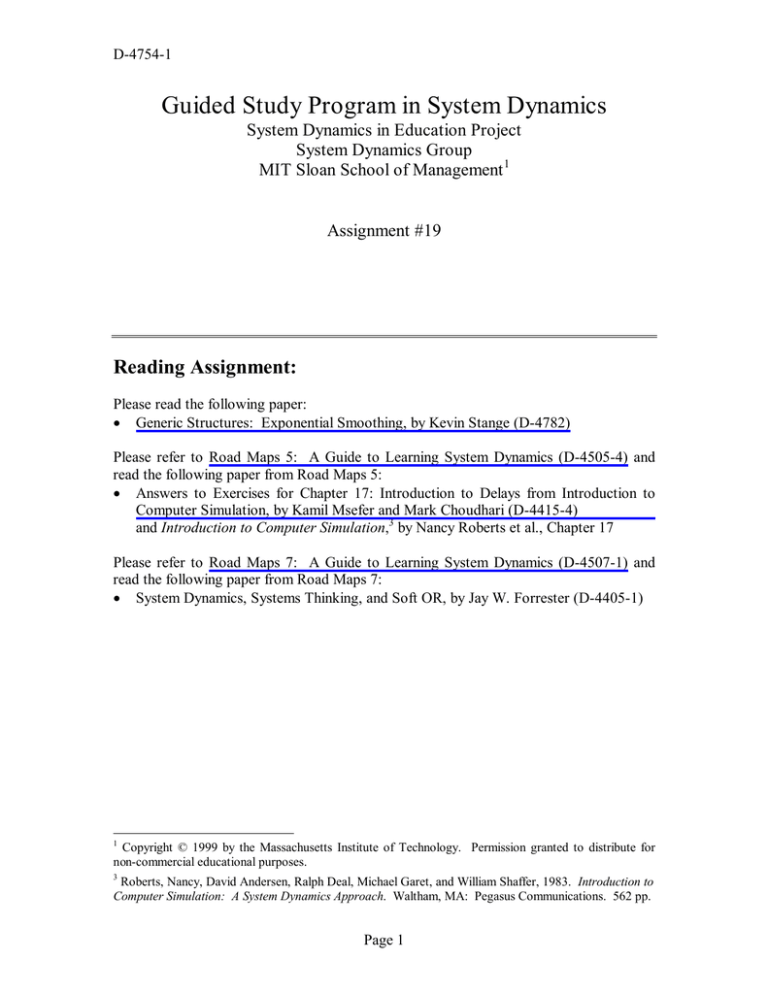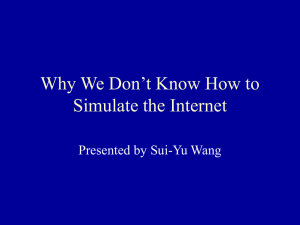Document 13624389
advertisement

D-4754-1 Guided Study Program in System Dynamics System Dynamics in Education Project System Dynamics Group MIT Sloan School of Management1 Assignment #19 Reading Assignment: Please read the following paper: • Generic Structures: Exponential Smoothing, by Kevin Stange (D-4782) Please refer to Road Maps 5: A Guide to Learning System Dynamics (D-4505-4) and read the following paper from Road Maps 5: • Answers to Exercises for Chapter 17: Introduction to Delays from Introduction to Computer Simulation, by Kamil Msefer and Mark Choudhari (D-4415-4) and Introduction to Computer Simulation,3 by Nancy Roberts et al., Chapter 17 Please refer to Road Maps 7: A Guide to Learning System Dynamics (D-4507-1) and read the following paper from Road Maps 7: • System Dynamics, Systems Thinking, and Soft OR, by Jay W. Forrester (D-4405-1) 1 Copyright © 1999 by the Massachusetts Institute of Technology. Permission granted to distribute for non-commercial educational purposes. 3 Roberts, Nancy, David Andersen, Ralph Deal, Michael Garet, and William Shaffer, 1983. Introduction to Computer Simulation: A System Dynamics Approach. Waltham, MA: Pegasus Communications. 562 pp. Page 1 D-4754-1 Exercises: 1. Generic Structures: Exponential Smoothing A. Describe a situation in which you have used information smoothing. B. Using the generic structure presented in this paper, build a simple model based on the situation you described in part A. As the “ACTUAL STATE OF SMOOTHED VARIABLE,” use any combination of step or pulse functions that you think are appropriate. In your assignment solutions document, include the model diagram and documented equations. C. Simulate the model and explain the behavior that you observe. In your assignment solutions document, include a graph of model behavior. Explain how the simulation output relates to the actual situation you described in part A. 2. Answers to Exercises for Chapter 17: Introduction to Delays from Introduction to Computer Simulation Read the above paper and the sections from Chapter 17 of Introduction to Computer Simulation that the paper asks you to read, and work through all of the exercises. Starting from Exercise 2, you will need to use the PULSE function in Vensim PLE, which works differently from the PULSE function in DYNAMO. The general form of the PULSE function is: PULSE(start,duration) Here are some hints for formulating the “dump rate” equation in the Nobug model: • define a constant “AMOUNT DUMPED” and set it equal to 420 gallons • include a shadow variable for the time step • define the equation for “dump rate” as: dump rate = AMOUNT DUMPED * PULSE(1,TIME STEP) / TIME STEP4 To “simulate repeated batches,” as in Exercise 3, add another PULSE formulation to the above “dump rate” equation, only with a different start time. When you have finished working through all the exercises that are answered in the paper, please answer the following question: 4 See the general solutions to assignment 17 for an explanation of this equation. Page 2 D-4754-1 What policy would you recommend to stabilize the oscillations produced by the apartment construction model in Exercise 7? Why? In your assignment solutions document, include the modified model diagram, documented equations, and behavior graphs of “Apartments in Construction” and “Apartments Completed,” comparing the behavior of the two models. Explain how the policy that you proposed created the observed behavior. 3. System Dynamics, Systems Thinking, and Soft OR Please read this paper carefully and answer the following questions: A. On page 4, Professor Forrester answers the question of model validity in the following way: “One can achieve only a degree of confidence in a model that is a compromise between adequacy and the time and cost of further improvement. The proper basis of comparison lies between the simulation model and the model that would otherwise be used. That competitive model is almost always the mental model in the heads of the people operating in the real system.” To what extent does this proposition agree or disagree with the propositions presented by Raymond Shreckengost in Dynamic Simulation Models: How Valid Are They (D-4463)? B. On page 11, Professor Forrester lists three possible consequences of system thinking. From your experience or the experience of your colleagues, provide an example of systems thinking being used constructively and an example of systems thinking being used detrimentally. 4. Understanding Oscillatory Systems This is the third in a series of exercises designed to help your understanding of oscillatory systems. Build the following model in Vensim PLE and then complete the exercises. Make sure that the time step is smaller than 0.0625 (or small enough that the value of DT no longer has a substantial effect on the result of the simulation). The time horizon over which you simulate the model should be at least 16 units of time. Page 3 D-4754-1 <Time> Stock Stock 2 flow flow2 period amplitude Pi amplitude = 1 flow = amplitude * SIN(2*Pi*Time/period) flow2 = Stock period = 2*Pi Pi = 3.14159 Stock = INTEG (flow, –1) Stock 2 = INTEG (flow2, 0) TIME STEP = 0.0078125 Notice that “flow2” is not an outflow from “Stock”; only the information about the value of “Stock” is used as the input to “flow2.” A. Simulate the model. In your assignment solutions document, include graphs of the behavior of the “flow,” “Stock,” and “Stock2.” Describe the relationships between each pair of the three graphs. B. Create a new dataset and simulate the model with “amplitude” equal to 2. In your assignment solutions document, include graphs of the behavior of the “flow,” “Stock,” and “Stock2” in this simulation. You may wish to change the initial value of the “Stock.” Describe the relationship between each pair of the three graphs and compare the simulation to that from part A. C. Repeat part B with “amplitude” equal to 0.5. D. What conclusions can you make about the relationship between an oscillating “flow” and “Stock2” as the amplitude of the “flow” changes? E. Repeat part B with “period” equal to Pi. Page 4 D-4754-1 F. Repeat part B with “period” equal to 4*Pi. G. What conclusions can you make about the relationship between an oscillating “flow” and “Stock2” as the period of the “flow” changes? Page 5




